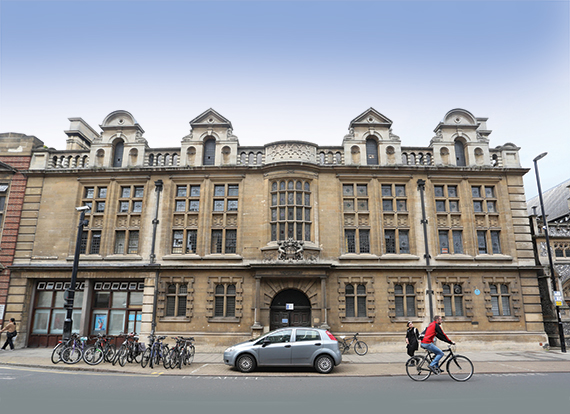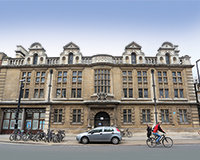
The corporate culture at Amazon is not chatty, so it is no surprise the giant US corporate chose to remain tight-lipped when EG approached it about a 60,000 sq ft office letting in Cambridge.
Fortunately others aren’t so reticent, and you can hear the excited gossip from Hills Road, CB1, up to Milton Road, CB4, and all points in between.
The arrival in the city centre of the UK’s most hyperactive property occupier marks a turning point for the Fenland business hub.
Amazon’s much-anticipated signing at 1 The Square follows Microsoft’s 2012 decision to decamp into 83,000 sq ft at Brookgate’s CB1 Station Road, which followed Siemens (2013), Apple (2014) and soon AstraZeneca. Other recent arrivals include super-cool businesses with young urban-focused workforces such as Spotify.
Demography is the key issue here. The younger the workforce, the more likely their senior managers are to add a city centre address to the relocation shortlist, says Brookgate chief executive Sven Topel. The flip side of youthful enthusiasm for the city centre is that the 40-somethings want to stay on the northern fringe sites.
The suggestion that Amazon will soon be paying him rent is discreetly brushed aside by Topel. However, he is happy to talk about the way newcomers to Cambridge are smiling on the city centre. In the old days, he says, they would have headed for the northern fringe science and business parks – today they want the urban buzz.
“The city centre is now their first port of call,” he says. “It’s their number one priority.”
Brookgate is presiding over another 160,000 sq ft of speculative floorspace at 50 and 60 Station Road, funded to the tune of £87m by Aviva Investors. The Grimshaw-designed scheme is due for completion in 2019.
The conclusion most observers draw is that the city centre’s growth will not be at the expense of the business parks, whose long-term future is pretty much assured.
Will Mooney, partner at Carter Jonas, says the northern fringe business parks don’t need to worry. The appeal is there and – thanks to a new railway station – is likely to grow. “I’ve never managed to persuade anyone to move from northern fringe to city,” he says, pointing to ARM Holdings for proof.
Planning permission was granted in February to expand its Peterhouse Technology Park base from 178,000 sq ft to 377,000 sq ft. The park is owned by LaSalle Investment Management, which will work with Commercial Estates Group on the £55m expansion. ARM might have opted for the city centre, but didn’t. “The talent wants car parking,” Mooney insists.
Confidence in the future of the northern fringe sites is boosted by evidence that demand for floorspace still easily outstrips supply. Supply of good northern fringe office space is said to be limited – 75,000 sq ft at most – and any occupier looking for 20,000-30,000 sq ft on the northern fringe would be wise to think of prelets.
So strong is demand, and so limited supply, that landlords like the Crown Estate, which Carter Jonas advises on their Cambridge Business Park, think it worthwhile taking back even very small suites for refurbishment and re-let: the latest was just 5,500 sq ft.
Topel confesses that luring occupiers from the northern fringe into the city is still a challenge, and will remain difficult. “We had a large science park occupier viewing CB1 last week and the fact is they like the way of life up there,” he explains. “They all have cars, and they use them. But the younger demographic wants something different, and that is what is driving them to consider cultural change.”
Nobody expects central Cambridge to mop up all demand – or to start vacuuming occupiers from the business parks. But everybody expects searches to widen so that city centre locations appear on every shortlist. The city centre will also win a high proportion of incoming relocations.
With the gap between city centre rents (peaking at around £36.50 per sq ft) and out-of-town rents (£30.50 per sq ft but rising to £33 for new space) now bridgeable by many occupiers, a city centre option on the shortlist seems appealing.
Will Heigham, head of office agency at Bidwells, says: “The rental difference between the two locations is now very close. That means so long as the northern fringe locations listen to the mood and make sure they provide amenities, they will always get occupiers.”
According to Heigham, if anyone faces a challenge it’s the city centre, not the northern fringe. The problem is that long-term supply is limited.
“The existing supply of new offices and development sites won’t go on for ever. We’ve work to do at CB1, but there aren’t acres of development land left.”
Topel explains: “It’s like this. We’ve started 160,000 sq ft speculative at Station Road, and there’s room for another 190,000 sq ft after that, and after we’ve got to watch what happens to the Cambridge Assessment Centre which is leaving a 300,000 sq ft office complex on university land at the station. That could be available for development, but maybe not – the university is expanding and might need the land itself.”
For now the mood is upbeat: hooray, Amazon is coming! Tomorrow, as the city centre market looks forward to the next wave of incomers, some serious thinking will need to be done.
Camditch
As Cambridge meets cool tech a new business hybrid is being created. So welcome to Camditch – the East Anglian Shoreditch.
To anyone who’s known Cambridge for decades – four or five of them – it’s hard to think of it as remotely cool or “urban”. But things have changed fast and there are serious signs that the smaller funky start-ups that made Shoreditch the place to be are heading to the Fens.
William Clarke, an associate director at Savills, reports a flurry of smaller deals in the city centre including Raspberry Pi’s relocation from the northern fringe to take 7,000 sq ft at Station Road. “This is a pioneering tech business – it’s interesting they’ve decided to move to the city centre,” he says.
The 20,000 sq ft Bateman House, Hills Road, has scooped four smaller lettings with more under offer. “This is a new business sector coming into a zone they wouldn’t have come to before,” says Clarke, who is advising landlord Trinity Hall.
The arrival of the co-working operators – expected any day – will confirm what many agents and landlords already believe: that the hipsters are on their way. Brookgate already operates a fully let 20,000 sq ft business centre and are adding another 5,500 sq ft to meet growing start-up demand.
Meanwhile, out at the science park, Central Working have teamed up with Trinity College, and are due to launch next spring. The 40,000 sq ft digital hub has received £4.8m government funding and is intended to house 500 new start-ups.
The city centre’s big test will come at Hobson House, St Andrew’s Street. The quirky 20,000 sq ft building is just the kind of space co-working hipsters will love, says Cheffins’ head of commercial agency Philip Woolner. Co-working operators are said to be sniffing around.
Meanwhile Brookgate’s CB1 is busy trying to attract a hipster-friendly retail and leisure offer.
“We’re trying to make sure it’s the right stuff,” says Bidwell’s Will Heigham, who is also meeting a lot more two-to-five-person start-ups.
“We’ve done viewings in suits, and we feel overdressed,” he says. “The co- working operators are still focused on London, but when they move outside the M25, they will be knocking on our door.”











